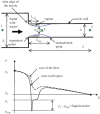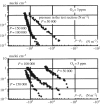Fluid dynamics of acoustic and hydrodynamic cavitation in hydraulic power systems
- PMID: 28413332
- PMCID: PMC5378230
- DOI: 10.1098/rspa.2016.0345
Fluid dynamics of acoustic and hydrodynamic cavitation in hydraulic power systems
Abstract
Cavitation is the transition from a liquid to a vapour phase, due to a drop in pressure to the level of the vapour tension of the fluid. Two kinds of cavitation have been reviewed here: acoustic cavitation and hydrodynamic cavitation. As acoustic cavitation in engineering systems is related to the propagation of waves through a region subjected to liquid vaporization, the available expressions of the sound speed are discussed. One of the main effects of hydrodynamic cavitation in the nozzles and orifices of hydraulic power systems is a reduction in flow permeability. Different discharge coefficient formulae are analysed in this paper: the Reynolds number and the cavitation number result to be the key fluid dynamical parameters for liquid and cavitating flows, respectively. The latest advances in the characterization of different cavitation regimes in a nozzle, as the cavitation number reduces, are presented. The physical cause of choked flows is explained, and an analogy between cavitation and supersonic aerodynamic flows is proposed. The main approaches to cavitation modelling in hydraulic power systems are also reviewed: these are divided into homogeneous-mixture and two-phase models. The homogeneous-mixture models are further subdivided into barotropic and baroclinic models. The advantages and disadvantages of an implementation of the complete Rayleigh-Plesset equation are examined.
Keywords: Rayleigh–Plesset equation; acoustic cavitation; barotropic and baroclinic models; hydrodynamic cavitation; nozzle discharge coefficient; sound speed.
Figures




















Similar articles
-
Modelling cavitation during drop impact on solid surfaces.Adv Colloid Interface Sci. 2018 Oct;260:46-64. doi: 10.1016/j.cis.2018.08.004. Epub 2018 Aug 25. Adv Colloid Interface Sci. 2018. PMID: 30195460 Review.
-
Non-contact method for analysis of cavitating flows.Ultrasonics. 2017 Nov;81:178-186. doi: 10.1016/j.ultras.2017.03.011. Epub 2017 Mar 16. Ultrasonics. 2017. PMID: 28711033
-
Hydrodynamic cavitation for sonochemical effects.Ultrason Sonochem. 1999 Mar;6(1-2):53-65. doi: 10.1016/s1350-4177(98)00030-3. Ultrason Sonochem. 1999. PMID: 11233938
-
Modeling cavitation in a rapidly changing pressure field - application to a small ultrasonic horn.Ultrason Sonochem. 2015 Jan;22:482-92. doi: 10.1016/j.ultsonch.2014.05.011. Epub 2014 May 22. Ultrason Sonochem. 2015. PMID: 24889548
-
CFD-assisted modeling of the hydrodynamic cavitation reactors for wastewater treatment - A review.J Environ Manage. 2022 Nov 1;321:115982. doi: 10.1016/j.jenvman.2022.115982. Epub 2022 Aug 26. J Environ Manage. 2022. PMID: 36104886 Review.
Cited by
-
Clinical and Microbiological Effects of Weekly Supragingival Irrigation with Aerosolized 0.5% Hydrogen Peroxide and Formation of Cavitation Bubbles in Gingival Tissues after This Irrigation: A Six-Month Randomized Clinical Trial.Oxid Med Cell Longev. 2020 Jul 31;2020:3852431. doi: 10.1155/2020/3852431. eCollection 2020. Oxid Med Cell Longev. 2020. PMID: 32802264 Free PMC article. Clinical Trial.
-
Modeling the Voltage Produced by Ultrasound in Seawater by Stochastic and Artificial Intelligence Methods.Sensors (Basel). 2022 Jan 30;22(3):1089. doi: 10.3390/s22031089. Sensors (Basel). 2022. PMID: 35161834 Free PMC article.
-
Towards the development of cavitation technology for gas hydrate prevention.R Soc Open Sci. 2021 Aug 4;8(8):202054. doi: 10.1098/rsos.202054. eCollection 2021 Aug. R Soc Open Sci. 2021. PMID: 34386246 Free PMC article.
References
-
- Fortes-Patella R, Choffat T, Reboud JL, Archer A. 2013. Mass loss simulation in cavitation erosion: fatigue criterion approach. Wear 300, 205–215. (doi:10.1016/j.wear.2013.01.118) - DOI
-
- Petkovsek M, Dular M. 2013. Simultaneous observation of cavitation structures and cavitation erosion. Wear 300, 55–64. (doi:10.1016/j.wear.2013.01.106) - DOI
-
- Tsujimoto Y. 2006. Flow instabilities in cavitating and non-cavitating pumps. In Design and analysis of high speed pumps, pp. 7-1–7-24. Educational Notes RTO-EN-AVT-143, Paper 7. Neuilly-sur-Seine, France: RTO. See http://www.rto.nato.int/abstracts.asp.
-
- Tsujimoto Y, Kamijo K, Brennen CE. 2001. Unified treatment of flow instabilities of turbomachines. J. Propul. Power 17, 636–643. (doi:10.2514/2.5790) - DOI
-
- Pouffary B, Fortes-Patella R, Reboud JL, Lambert PA. 2008. Numerical simulation of 3D cavitating flows: analysis of cavitation head drop in turbomachinery. ASME Trans. J. Fluids Eng. 130, 061301 (doi:10.1115/1.2917420) - DOI
Publication types
LinkOut - more resources
Full Text Sources
Other Literature Sources
Research Materials

